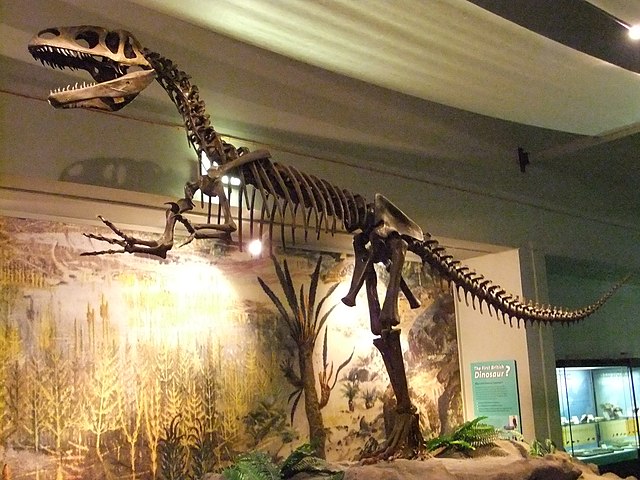新猎龙属
来自维基百科,自由的百科全书
新猎龙(属名:Neovenator,发音:nee-o-ven-a-tor,意为“新猎人”)是一属异特龙超科的兽脚类恐龙,生存于白垩纪巴列姆阶,约1亿2500万年前。自从化石于英国威特岛被发现之后,它成为最著名的欧洲大型肉食性恐龙之一。新猎龙身长约7.5公尺,并有著相对轻盈的体格,体重约1至2吨。[1]
发现与研究历史

第一块新猎龙骨头是于1978年夏季的一阵暴风造成农庄山脊的一部分坍塌时所发现的。含有化石的岩块坠落在怀特岛西南岸的闪石湾海滩。这些岩块由混色黏土岩与泥灰岩中的植物碎屑岩床所构成,属于威塞克斯层的一部分,地质年代可追溯至早白垩世巴列姆阶,约1亿2500万年前。这些化石首先由亨伍德(Henwood)家族所采集,紧接著由地质系学生大卫·理察斯(David Richards)接手。理察斯将化石送至怀特岛地质博物馆及伦敦自然史博物馆。在后者古生物学家亚伦·查理格将骨骼鉴定出属于两种不同的动物:禽龙和某种兽脚类。这些原本归入禽龙的化石现在重新建立为曼特尔龙,在当时引起较多关注,并于1980年代初期伦敦自然史博馆派出团队去搜寻更多这种动物的骨头,过程中发现了一个额外的兽脚类尾椎。

包括齐斯与简妮·席梦兹(Keith and Jenny Simmonds)在内的几位业馀古生物学家开始搜索兽脚类的其他遗骸。最后总共找到的骨骼部位包含:吻部、牙齿、前下颌、脊柱的大部分、肋骨、腹肋、人字骨、左肩胛骨、骨盆、一条后肢。这些化石的标本编号分别为 BMNH R10001和MIWG 6348。一共可建构出整体骨架的70%完整度。1985年由怀特岛博物馆的史帝夫·赫特(Steve Hutt)博士所领导的挖掘活动发现了属于第二只个体的两个脊椎:MIWG.5470标本。1987年简妮·席梦兹发现第三具骨架:MIWG.6352标本,包括脊椎与骨盆。第四只个体为IWCMS 2002.186标本,部位有下颌、脊椎、肢骨。1990年,赫特描述了一具当时认为是斑龙可能新种的骨骸,因为将MIWG 6352标本的坐骨误辨为耻骨而认为这标本代表不同物种。[2]

1996年赫特、大卫·马提尔(David M. Martill)、麦可·巴克(Michael J. Barker)命名、描述了模式种瑟氏新猎龙(Neovenator salerii)。属名由希腊语的neo~(新)与拉丁语的venator(猎人)组成。种名纪念发现地点的土地拥有者瑟列罗(Salero)家族。有鉴于整趟发现过程涉及了多名人士,将其中特定一位当作发现者并不恰当。正模标本为BMNH R10001与MIWG 6348。[3]
1999年赫特将新猎龙作为他尚未发表的硕士论文主题。[4]
2008年史蒂芬·布塞特、罗哲·班森(Roger Benson)及赫特发表了新猎龙更详尽的重新描述。[5]
2012年在法国巴列姆阶的盎格克褐煤尸骨层(Angeac lignitic bone bed)发现了与新猎龙正模标本类似的牙齿。[6]
描述




新猎龙测量身长约7.6公尺、身体结构轻盈,体重介于1至2吨。[7]MIWG 4199标本是个身长可能有10公尺的个体,但因为只有趾骨其列为新猎龙的有效性仍待考证。[8][9]
以下整理出数篇关于新猎龙研究中所提到的鉴定特征:
- 鼻骨长度是高度的两倍[3]
- 吻部前上颌骨有五颗牙齿[3]
- 上颌骨由一个巨大孔洞所穿透,直径是齿列的六倍长度[3]
- 齿冠占整颗牙齿长度的四分之一[3]
- 趾爪顶部有凹槽[3]
- 两块前上颌骨由一个延伸的插座状连结[10]
- 枢椎椎间体(intercentrum)前关节面横向加宽[5]
- 枢椎齿状突(odontoid process)沿前表面侧缘有小开孔[5]
- 枢椎神经突侧面有单一开孔[5]
- 后部颈椎与颈肋愈合[5]
- 第八与第九颈椎在稚骨下横突(parapophysis)(下方肋骨的关节面)可以看到骨头内部的驼峰结构[5]
- 前部颈椎下侧构成尖锐龙骨突,并非从侧面嵌入[5]
- 前部背椎下部隆起的前表面缘椎下突(hypapophyses)构成矮丘状[5]
- 后部背椎关节突表面以弯曲轮缘侧向延伸[5]
- 肩关节横向(前后测量)宽度大于长度[5]
- 髂骨前片下侧的凹槽内侧有个架状[5]
- 坐骨足前部相连、后部分叉[5]
- 股骨头朝前、上、内斜[5]
- 股骨小转子外侧有道厚脊[5]
- 股骨第四转子上界外侧有个拇指印形凹陷[5]
- 股骨前下侧近乎平坦,只在下髁突之间有道短的垂直凹陷[5]
- 胫骨下部有个椭圆形粗糙区域[5]
- 胫骨外踝顶部前后收缩[5]
- 胫骨顶面外前凸有个朝下的骨刺[5]
- 足部第二跖骨外侧有与第三跖骨接触的中空表面[5]
有些一度认为是新猎龙的自衍征,后来研究显示这些特征也存在于其他兽脚类:
2015年的研究指出新猎龙吻部前面有个复杂的神经血管系统,可作为感觉器官。此特征亦存在于棘龙科,它们借此在水中感应猎物。但在新猎龙的功能仍有疑问。[11]
分类
新猎龙刚被描述时被认为是欧洲唯一已知的异特龙科。然而进一步研究显示新猎龙与异特龙超科中更进阶的鲨齿龙科有著更多共通点,可能是最原始的鲨齿龙类。数个研究都认为虽然新猎龙与鲨齿龙科有关连,它们一同构成鲨齿龙类,前者事实上却与大盗龙类更为近缘,两者一同构成新猎龙科演化支。[12]其他研究则支持新猎龙属于鲨齿龙科,而大盗龙类属于暴龙超科。
| 新猎龙科 Neovenatoridae |
| |||||||||||||||||||||||||||||||||||||||
| |||||||||||||||||||||||||||||||||||||||||||||||||
古生物学

克里斯·巴克(Chris Barker)与同事根据在新猎龙头骨上发现的神经血管结构,认为其吻部可能有著外皮感应构造,如同现代水禽与鳄鱼用来在泥中侦测食物的构造。因为新猎龙被认为是完全陆生动物,此构造可能有著与现代动物不同的其他功用,如对压力、温度的感度;控制下颌压力;准确地进食。新猎龙牙齿磨耗似乎显示它在进食时会避免咬到骨头,可支持前述论点。另外新猎龙也可能在求偶或感应巢穴条件使用此外皮感应构造,如同在现代多数鳄类及大型鸟类所观察到的现象。虽然在另一种暴龙科的惧龙也发现过这类神经血管构造,但新猎龙是目前所知兽脚类中发现保存最良好及最完整的。[15][11]
新猎龙正模标本显示出许多病征,描述论文中提到的有:中部尾椎有愈合痕迹、中部尾椎横突有断裂后愈合痕迹、脚掌掌骨有骨刺、腹肋骨有断裂后愈合痕迹、某些断裂处形成假关节、……以及肩胛骨也有断裂。[16]
古生态学

在早白垩世的威塞克斯层中,新猎龙可能与其他恐龙共享栖地,如重爪龙、多刺甲龙、禽龙、始暴龙。正模标本与曼特尔龙骨骼混杂在一起,挖掘现场还发现鱼类、两栖类、蜥蜴、翼龙类、棱角鳞鳄科遗骸。新猎龙是当时的顶级掠食者之一。
参考来源
外部链接
Wikiwand - on
Seamless Wikipedia browsing. On steroids.

